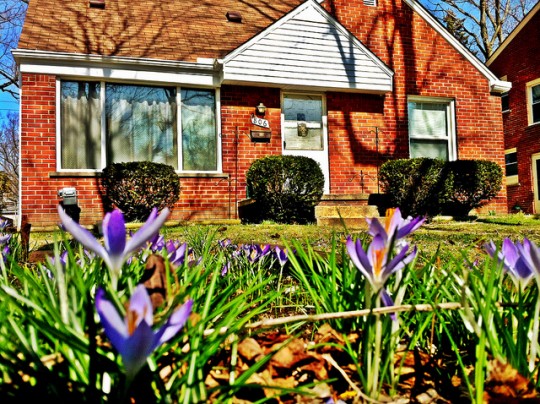Trulia’s Housing Barometer tracks how quickly the market is returning to normal based on five measures, including delinquency and foreclosure rates, new construction, existing home sales, home prices, and the employment rate for 25-34 year olds. According to the most recent release, four of the five indicators have improved over the last year. In fact, only construction starts fell behind over the past 12 months, dropping to 44 percent back to normal from 45 percent the year before. But, though real estate has been rebounding, the recovery has been slow and, at times, volatile. Housing affordability has been a part of the reason for this, as has the declining presence of real-estate investors in the market. Last year, when there were more distressed properties available for sale, investors were more active, buying homes to eventually put up for rent. This activity was, in large part, responsible for last year’s home price increases and also a percentage of the accelerated sales pace. This year, however, investors are less active in the market, which means prices likely won’t rise as quickly and home sales may appear slower than last year’s pace. More here.
Tag Archive for affordability
Housing Market Continues To Gain Strength
Freddie Mac’s new Multi-Indicator Market Index measures the stability of the nation’s housing market based on home purchase applications, payment-to-income ratios, proportion of on-time mortgage payments, and the local employment picture. Based on these components, the Index determines how each market is trending and whether it’s becoming more or less stable. Overall, the housing market is in better shape than it has been at any point since the beginning of the Great Recession. Since June 2009, for example, home sales are up 13 percent, housing starts are up 55 percent, serious delinquencies are down 32 percent, and the unemployment rate has fallen from 9.5 percent to 6.7 percent. Still, there is room for improvement. Len Kiefer, Freddie Mac’s deputy chief economist, said – in many markets – a better employment picture, along with some income growth, makes it possible for people considering buying a home to stay within reasonable payment-to-income ratios. But, according to Kiefer, some high-cost markets are starting to feel an affordability pinch. Of the 50 states included in the Index, 25 plus the District of Columbia are improving based on three-month trends. Among the 50 metropolitan areas included, 35 are improving. Freddie Mac expects more markets to move closer to their long-term stable range as we enter the spring home buying season. More here.
96% Of Local Markets Better Off Than 4 Years Ago
Among 410 U.S. counties recently analyzed by RealtyTrac, 96 percent were better off than they were four years ago, at the peak of the foreclosure crisis. The analysis looked at four key categories of housing market health, including home price appreciation, affordability, percentage of bank-owned sales, and the unemployment rate. Daren Blomquist, vice president at RealtyTrac, said the housing recovery has taken root in hundreds of counties across the country and almost all local markets are better off than they were in 2010. And most analysts expect continued improvement this year. According to Blomquist, though price gains have caused a drop in affordability in some areas, builders and homeowners that have regained equity should help boost for-sale inventory, which will balance those markets and moderate price increases. Also in the report, just 8 percent of county housing markets are better off than they were before the housing bubble burst in 2006 – but 30 percent were healthier than six years ago, when the Great Recession began. More here.
Home Sales Expected To Pick Up In Spring
The number of previously owned homes sold in February was virtually unchanged from the month before, according to data recently released by the National Association of Realtors. Total existing-home sales dropped just 0.4 percent from January and are now 7.1 percent below year-before levels. Lawrence Yun, NAR’s chief economist, said there were unusual weather disruptions across much of the country in February and that, along with constrained inventory and less favorable affordability conditions, led to a largely unchanged sales rate. But Yun expects sales to pick up over the months ahead, adding that some transactions are simply being delayed and, with an expected improvement in job creation, home sales should trend up modestly over the course of the year. In fact, in regions where winter weather wasn’t an issue, home sales have already risen. The West and South both saw sales increases in February, while the Midwest and Northeast experienced declines. Also, the median existing-home price for all housing types was $189,000, which is 9.1 percent above February 2013. More here.
Cost of Buying Rises, Still Cheaper Than Rent
With last year’s price and mortgage rate increases, the estimated monthly house payment for a median-priced, three-bedroom home has risen, according to a new analysis from RealtyTrac. But, though affordability levels have fallen, buying a home was still cheaper than renting in 91 percent of the 325 counties included in the report. Daren Blomquist, vice president at RealtyTrac, said the monthly cost of owning a home is still less than renting in the majority of markets but a combination of rising home prices and increasing interest rates during the second half of 2013 has caused the cost of owning a home using traditional financing to jump over the last year. In fact, the estimated monthly payment – including mortgage, insurance, taxes, maintenance, and subtracting the estimated income tax benefit – increased an average of 21 percent from a year earlier. The increase was driven, in part, by a 10 percent spike in median prices across the 325 counties included in the analysis. More here.
Housing Headed In The Right Direction
Freddie Mac’s U.S. Economic and Housing Market Outlook for January finds four of the key housing indicators moving in the right direction to begin the year. The unemployment rate, though still high at 6.7 percent, is vastly improved and should continue its gradual path to a more consistent and historically normal level. Mortgage delinquencies have also shown great improvement, having been nearly cut in half since their peak. Finally, both affordability levels and home sales continue to trend in the right direction, with the average mortgage payment remaining very affordable in most markets – suggesting there’s still room for more recovery in home prices. Frank Nothaft, Freddie Mac’s chief economist, said the housing recovery continues on a steady pace. According to Nothaft, home prices should rise about 5 percent this year, while home sales – along with other key indicators – will continue to trend in the right direction. More here.
Realtor Report Finds Optimistic Outlook
According to a monthly survey of Realtors, market conditions are still good, though not as strong as before. The survey – which measures confidence in the current market and expectations for the future – provides monthly information about buyer/seller traffic, price trends, buyer profiles, and issues affecting the real-estate market. Despite little change in overall perception from October to November, Realtor confidence in the market for single-family homes over the next six months jumped four points, rising to 64 from 60 in October. The survey is scored so that any number above 50 indicates moderate market conditions. According to respondents, buyer traffic slowed in late autumn but is expected to pick up now that the holidays are over and the spring-selling season is only a few months away. Also in the report, a seasonal slowdown in home prices combined with steady mortgage rates and rising incomes has lead to a slight boost in affordability, though the overall trend remains down. More here.







